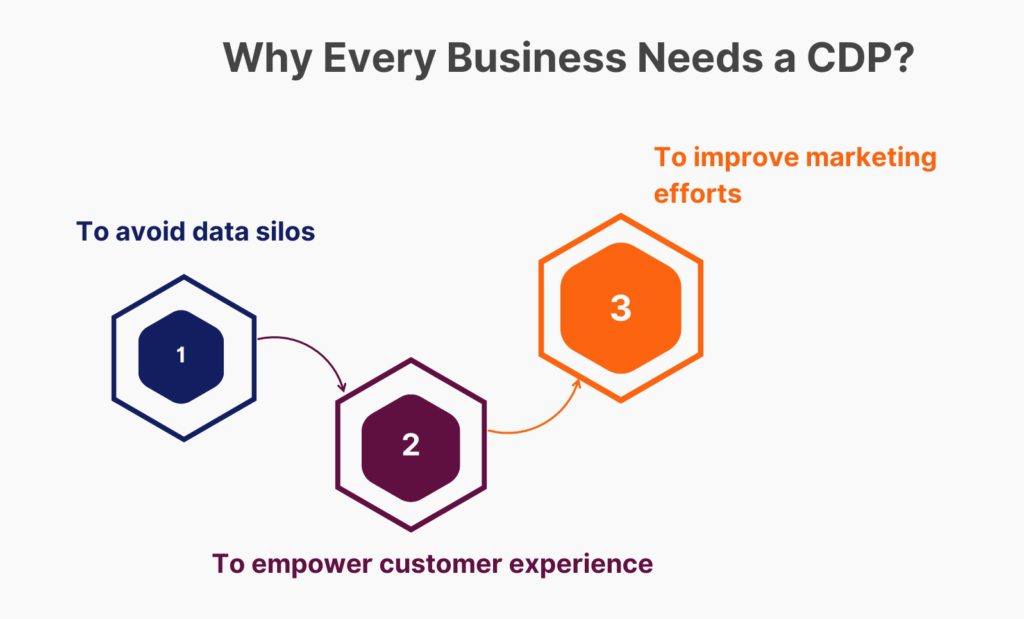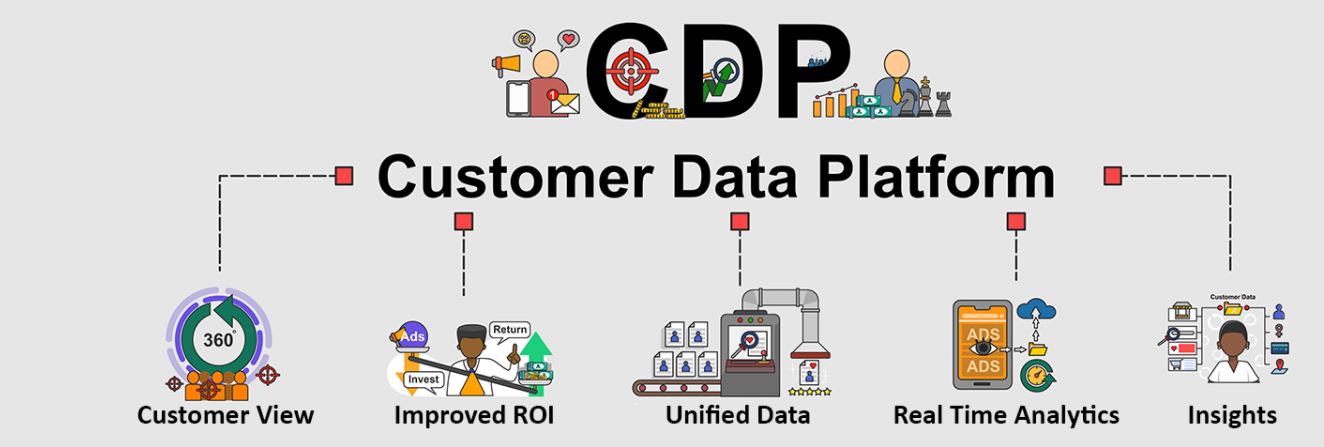This guide explains the concepts of a B2C Customer data platform (CDP) and predictive analytics, and how businesses, big and small, can benefit from these technologies. How a B2C CDP Customer Data Platform can deliver a customer-centric experience: read a complete guide.
Customer personalization at scale is one of the biggest challenges a marketer faces today. Just how to cater to individual customers, that too, in real-time is a question they grapple with daily.
Without a doubt, today’s customers demand personalized treatment. Which works well for both ends of the demand-supply chain.
Personalization keeps customers happy, thus helping in their retention in a big way, and it also helps companies grow measurably; some studies show a growth of at least 3 times more.
Thus, personalization should not be seen as a hurdle but an opportunity for growth.
Two things help achieve customer personalization: human resources (read: your marketing) and technology.
But one of the biggest hurdles on this path is fragmented customer data. This is where a technology like a customer data platform (CDP) comes in.
Use Customer information management (CIM) for better Recommendations on your recommendation engine
A B2C customer data platform (CDP) can help in your organization’s efforts to interpret customer data to create effective personalized experiences. At the very basic level, a CDP collects and unifies all customer-related data, across online and offline touchpoints, to draw up a 360deg view of a single customer. Thus, it helps:
- Manage fragmented data across all channels
- Provide the capability to track customer behavior
- Make intelligent recommendations based on triggers (in real-time)
What a B2C Customer data platform can also provide is the ability to maximize the combined power of predictive analytics and artificial intelligence/machine learning. A B2C CDP Customer data platform can be used on top of your MarTech to run predictive models to turn your big data into valuable insights that guide marketing decisions. Predictive models identify patterns from the unified data, which, in turn, helps businesses understand what is most likely to happen next in a customer’s journey. This helps in throwing up the right offer to the right customer in real-time through the right channel.
The combination of a CDP, predictive analytics, and ML can unleash new opportunities for your business. No longer is your business forced to react to the last action of a customer, but it can now influence a buyer’s decisions by launching analytics-based calls to action during their journey, thus maximizing sales.

This guide explains the concepts of a B2C Customer data platform (CDP) and predictive analytics, and how businesses, big and small, can benefit from these technologies.
B2C Marketing Challenges
Digital marketers today face several challenges as the market gets more and more competitive. We have listed some of them here, not necessarily in any order of priority.
- Creating a personalized and consistent customer experience
Delivering tailored, meaningful, and relevant customer experience (CX), be it offers or content or other messages remains a challenge that marketers face. Over the years, customer expectations have gone up, compelling companies to increasingly invest in the personalization of CX. Thus, one of the most important challenges today is meeting the exact customer expectations and delivering superior CX consistently across all channels.
- Optimizing multi-channel marketing
On the list of modern-day marketers, the “To-do” list is maximizing business for all the marketing channels. These range from social media networks, direct mail, email; even online chat. Marketers need to focus on selling their products from multiple channels but in a manner that is seamless and without any hiccups for the customer.
- Not getting quick insights in real-time
Another hurdle is the inability to get consumer insights quickly enough. To personalize interaction with your customers, a marketer needs analysis in real-time. If that does not happen, many business decisions are often based on half-truths and gut feelings. It also makes tracking the results of marketing efforts equally difficult.
Predictive Analytics Definition And Modeling
One of the tools available to help marketers interact with customers at a granular level is predictive analytics, often dubbed as “the proactive part” of data analytics. Predictive Modeling refers to the use of algorithms to analyze data collected on previous events to predict the outcome of future events.
Predictive analytics helps a business forecast a customer’s needs, and serve up offers accordingly. This also helps upsell/cross-sell. What’s more, it also helps optimize product pricing models.
Predictive modeling offers a customized approach for marketing. A “one sizes fit all approach” is usually not ideal for your marketing strategy, as the needs of your business might differ significantly from what works in a different environment.
A better approach in our opinion is Express Analytics’ ability to customize predictive models for your specific business requirements.
Use case of predictive analytics
The most significant advantage you can gain from using predictive modeling is how easy it is to generate actionable insights; because the insights gained from predictive modeling are solely based on the data from your organization’s actual business behavior, it is tailored specifically for your business’s needs and strategies. The other advantage is the value it offers in marketing spending. Predictive modeling can be used to understand which customers will buy the most.
Personalization for customers
Getting to know customer behavior and consumer demography is the first step in predictive analytics. Retailers can use it to give targeted and highly customized offers for specific shoppers.
Much before data analytics was commercially adopted, marketers could not make targeted offers. But with the advance in tech, online shopping, and data analytics, it is now possible to track behavior across channels.
Such insights coupled with predictive analytics can help retailers make personalized offers at a very granular level. This can be enhanced by offers to drive more purchases.
As a matter of fact, predictive analytics can be used to upsell or even cross-sell. Eg: Based on her previous history, a retailer found that Jane was buying X brand of milk at the start of every month. Using predictive analytics, a retailer can now offer Jane 1 pack of sugar-free on the purchase of 2, in the middle of the month, even.
Customer Behavior Or Behavioral Analytics
People-tracking technology has now made it easy for retailers to find ways of analyzing in-store or online shopping behavior, and assess the impact of merchandising efforts.
Data can be collected from a host of consumer interaction points – mobile, social media, e-commerce sites, credit card swipes (transaction), etc. This means a retailer today has access to diverse (and complex) data about its customers.
Using this and even data points captured from earlier marketing and advertising campaigns, retailers can now build predictive models to link past behavior and demographics. Such models aim to score every customer according to the likelihood of them buying certain products.
This entire data-based process also gives retailers invaluable insights into recognizing their high-value customers, establishing the CLV, a customer’s motives behind a purchase, the buying patterns, the preferred channels, and so on.
What Is A B2C customer data platform And What Are Its Benefits?
Like we said earlier in this presentation, a B2C customer data platform (CDP) is a “data unifying software”. Adding it on top of your MarTech stack helps manage your customer experience across every touchpoint — marketing, customer service, and product. It collates an organization’s data from all sources — batch, streaming, structured or unstructured, transaction or demographic — and makes it available 24X7 to all the enterprise users. A CDP is a sophisticated data hub where all things related to data converge — from data sources to customer information.
A B2C customer data platform and customer personalization
Every customer inevitably leaves behind traces of his activity while interacting with a brand. When they interact with a brand using other online and offline channels like websites, e-commerce platforms, and in-store interactions, their footprints can be tracked.
A b2c customer data platform can help you catch and visualize instant insights from your data in real-time. You may drill down as much as you want to capture the “connect” between what looks like unrelated data. In this way, it brings together certain categories of customers into a basket, thus segmenting them.
Such customer segmentation can help you in many ways: It helps a business develop focused strategies to hold on to its top-paying customers. Or, to re-engage those clients who haven’t purchased in a while. It is also used to provide a heightened customer experience.
Are you ready for your business transformation?
In Conclusion:
To succeed, businesses today need to design their products or services to meet an individual customer’s requirements. Marketing has to be in that vein. Marketing messaging has to be highly personalized. The use of a b2c Customer data platform and predictive analytics allows all of that. Express Analytics’ Oyster is packed with automation capabilities that make day-to-day marketing tasks highly effective. Oyster goes beyond merely integrating various sources of data.
It provides actionable intelligence obtained from various data points that can be integrated across all the business cells. A CDP enables brands to make intelligent decisions around the right audience, giving them the right content at the right time using the right channel for the purpose.
Find out how Oyster can help your business.
Sign up for a demo.
Build sentiment analysis models with Oyster
Whatever be your business, you can leverage Express Analytics’ customer data platform Oyster to analyze your customer feedback. To know how to take that first step in the process, press on the tab below.
Liked This Article?
Gain more insights, case studies, information on our product, customer data platform


No comments yet.